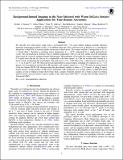| dc.contributor.author | Simcoe, Robert A. | |
| dc.contributor.author | Furesz, Gabor | |
| dc.contributor.author | Sullivan, Peter W | |
| dc.contributor.author | Hellickson, Timothy H | |
| dc.contributor.author | Malonis, Andrew C. | |
| dc.contributor.author | Kasliwal, Mansi | |
| dc.contributor.author | Shectman, Stephen A | |
| dc.contributor.author | Kollmeier, Juna A | |
| dc.contributor.author | Moore, Anna | |
| dc.date.accessioned | 2022-08-02T18:42:07Z | |
| dc.date.available | 2021-09-20T18:22:00Z | |
| dc.date.available | 2022-08-02T18:42:07Z | |
| dc.date.issued | 2019 | |
| dc.identifier.uri | https://hdl.handle.net/1721.1/132355.2 | |
| dc.description.abstract | © 2019. The American Astronomical Society. All rights reserved.. We describe test observations made with a customized 640 ×512 pixel indium gallium arsenide (InGaAs) prototype astronomical camera on the 2.5 m DuPont telescope. This is the first test of InGaAs as a cost-effective alternative to HgCdTe for research-grade astronomical observations. The camera exhibits a background of 113 e - s -1 /pixel (dark + thermal) at operating sensor temperature T = -40°C, maintained by a simple thermoelectric cooler. The optomechanical structure floats at ambient temperature with no cold stop, unlike most IR instruments which must be cooled to mitigate thermal backgrounds. Measurements of the night sky using a reimager scaled at 0.″4/pixel show that the sky flux in Y is comparable to the dark current. At J the sky exceeds dark current by a factor of four, dominating the noise budget. The read noise (∼43 e - ) falls below sky + dark noise for exposures of t > 7 s in Y and 3.5 s in J. We observed several representative science targets, including two supernovae, a z = 6.3 quasar, two local galaxies monitored for IR transients, and a galaxy cluster at z = 0.87. We observe a partial transit of the hot Jupiter HATS-34b, demonstrating the photometric stability to detect a 1.2% transit. A tiling of larger-format sensors would produce an IR survey instrument with significant cost savings relative to HgCdTe-based cameras, if one is willing to forego the K band. Such a camera would be sensitive for a week or more to isotropic emission from r-process kilonova ejecta similar to that observed in GW170817, over the full 190 Mpc horizon of Advanced LIGO. | en_US |
| dc.language.iso | en | |
| dc.publisher | American Astronomical Society | en_US |
| dc.relation.isversionof | 10.3847/1538-3881/AAE094 | en_US |
| dc.rights | Article is made available in accordance with the publisher's policy and may be subject to US copyright law. Please refer to the publisher's site for terms of use. | en_US |
| dc.source | The American Astronomical Society | en_US |
| dc.title | Background-limited Imaging in the Near Infrared with Warm InGaAs Sensors: Applications for Time-domain Astronomy | en_US |
| dc.type | Article | en_US |
| dc.contributor.department | MIT Kavli Institute for Astrophysics and Space Research | en_US |
| dc.contributor.department | Massachusetts Institute of Technology. Department of Physics | en_US |
| dc.relation.journal | Astronomical Journal | en_US |
| dc.eprint.version | Final published version | en_US |
| dc.type.uri | http://purl.org/eprint/type/JournalArticle | en_US |
| eprint.status | http://purl.org/eprint/status/PeerReviewed | en_US |
| dc.date.updated | 2020-11-09T14:39:00Z | |
| dspace.orderedauthors | Simcoe, RA; Fűrész, G; Sullivan, PW; Hellickson, T; Malonis, A; Kasliwal, M; Shectman, SA; Kollmeier, JA; Moore, A | en_US |
| dspace.date.submission | 2020-11-09T14:39:07Z | |
| mit.journal.volume | 157 | en_US |
| mit.journal.issue | 2 | en_US |
| mit.license | PUBLISHER_POLICY | |
| mit.metadata.status | Publication Information Needed | en_US |
